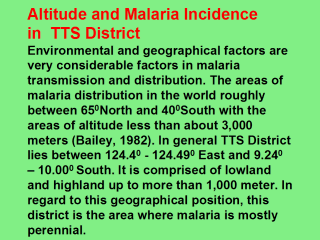 |
Although
malaria incidence in TTS District in 1995-2000 did not have a significant
correlation with altitude, there was a significant difference in malaria
incidence in the areas higher than 850 m above sea level, compared to the
other altitudes.
Many factors might be related to this situation. Lindblade
(2000) suggested that malaria is unstable in highland areas. It can make the
population in that area who have little or no immunity, vurneable to the
explosion of malaria when the vector density and weather conditions favor
transmission (Lindblade, 2000; MARA, 1998). In the areas over 850 m above
sea level, the malaria incidence pattern from the median malaria incidence
in 1995-2000 indicates that there were three peaks of malaria transmission
which are in May, August and December. This is one of the indicators that
malaria transmission in this area may be unstable. |
